The parameters of the chiller can be basically divided into:
- Chiller operating parameter.
- Chiller selection parameters
Chiller operating parameters:
The Chiller operating parameters are:
- Chiller compressor suction temperature.
- Chiller compressor suction pressure.
- Water temperature at the chiller outlet.
- Water temperature at the chiller inlet.
- Chiller refrigeration circuit high pressure.
- Chiller compressor discharge temperature high.
- Chiller compressor oil pressure.
- Chiller compressor oil level.
- Water pressure at the chiller inlet.
- Water pressure at the chiller outlet.
- Current consumption of the chiller compressor.
- Voltage of the chiller supply phases.
Chiller selection parameters
Some chiller selection parameters include:
- Thermal load to be cooled.
- Required chilled water temperature.
- Average outdoor ambient temperature.
- Available voltage.
- Permissible noise level.
- Partial thermal load values to be encountered.
- Unit size.
- Choice of refrigerant.
- Water pressures to be managed.
- The availability of water for condenser cooling.
Chiller Training:
The chiller is a machine that, through a refrigeration cycle, is used to constantly cool a flow of water. Ice water can be used to generate air conditioning, or to cool machines.
Generally the difference between the water temperature, between the outlet and inlet is 5 ° C 10 ° F.
The chiller can be used to generate temperatures in the water, from 7 ° C to temperatures below 0 ° C, where the use of glycol is necessary, to avoid freezing.
Chiller can be classified according to the temperature value that the water reaches.
- Conventional Chiller: For temperatures greater than 35 ° F generally for air conditioning and machine cooling applications.
- Medium and low industrial chiller for values between +20 ° F and + 35 ° F
- Low Temperature Industrial Chiller: Generally between + 20 ° F and -59 ° F.
- Chiller Ultra-low temperature industrial refrigeration: For ranges between -60 ° F and -112 ° F.
Chiller Classification Summary:
| Chiller Classification | Types: |
| According to the compressor | 1. Piston. 2. Scroll. 3. Screw. 4. Centrifugal. |
| According to condensation | 1. Water cooled condenser. 2. Air cooled condenser. |
| According to the outlet temperature of the chiller water. | 1. Conventional Chiller. 2. Medium temperature 3. Low temperature 4. Ultra Low Temperature. |
| According to the refrigeration cycle | 1. Compression refrigeration cycle. 2. Absorption refrigeration cycle. |
| Chiller according to engine speed | 1. Chiller with constant compressor speed, 2. Chiller with at least one inverter compressor. |
| Chiller according to evaporator | 1. Shell and Tube Chiller (Flooded) 2. Shell and Tube Chiller (Dried) 3. Housing and Serpentine Chiller 4. Double Tube Chiller. 5. Baudelot Type Chiller. 6. Plate Type Chiller. |
| Chiller according to the water-cooled condenser. | 1. Chiller with shell and tube condenser. 2. Chiller with welded plate condenser. 3. Chiller with Coaxial Tube condenser in tube. |
Chillers Manufacturers:
Some of the main manufacturers of chillers, we can see them in the following table,
| Chiller Manufacturer | Air cooled models | Water-cooled models |
| Chiller Carrier | AquSnap 30RAP AquSnap 30RB AquaForce 30XA AquaForce 30XV | AquaEdge 17DA Carrier AquaEdge 19DV Carrier AquaEdge 19XR Carrier AquaEdge 23XRV Carrier AquaForce 30HX Carrier AquaSnap 30MP Carrier AquaForce 30XW Carroer |
| Chiller York | Chiller York YCAL Chiller York YLAA: Chiller York YVAA Chiller York YVFA Chiller York YCIV | Chiller York YZ: Chiller York YK Chiller York YMC2 Chiller York YWVA Chiller York YCW Chiller York YD Chiller York YK-EP |
| Chiller Trane | Chiller Trane RTAE Chiller Trane CGAM Chiller Trane RTAC | Trane CenTraVac EarthWise Chiller Trane CenTraVAC Serie S Chiller Trane CenTraVAC Serie L Chiller Trane CenTraVac Duplex |
| Chiller Daikin | Daikin Pathfinder Daikin Trailblazer | Chiller Daikin Magnitude Chiller Daikin Navigator |
| Chiller Engie | Engie QUANTUM Engie QUANTUM GA Engie QUANTUM GS | Chiller Engie QUANTUM X: Chiller Engie QUANTUM G: Chiller Engie QUANTUM W Chiller Engie QUANTUM GA |
| Chiller Mirsubishi | Mitsubishi i-NX Mitsubishi NX2 2 Mitsubishi NX2 4 | Chiller Mitsubishi EACV / EAHV Serie e |
| Chiller Hitachi | Hitachi Serie AZPY1 Hitachi Serie V | Chiller Hitachi Serie WZPY Hitachi Direct-drive con VSD Hitachi Inverter GXG-SIT/ GSG-SIT |
First steps to select the chiller you need.
- Value of the minimum required temperature.
- With the minimum required temperature value, the type of chiller that is needed must be classified.
- Value of each water flow and its respective temperature value, to project the distribution and the piping system.
- With the distribution, a balance of supply and return flows is made, to know the true capacity of the chiller that is needed, so as not to oversize the equipment.
- According to the local hydraulic resources, economic resources and space, the chiller condenser is selected. Know the water treatment required by the facility.
Online Chiller Training Classes
Our online chiller training classes have simulators that allow studying the behavior of the chilled water plant, according to the thermal requirements of the application.
The chiller has a mostly compression refrigeration cycle that allows it to cool water flows continuously to the required values
Its basic parts are
- Evaporator.
- Compressor
- Condenser.
- Expansion valve
- Since the objective is to cool a flow of water, a hydraulic circuit is needed.
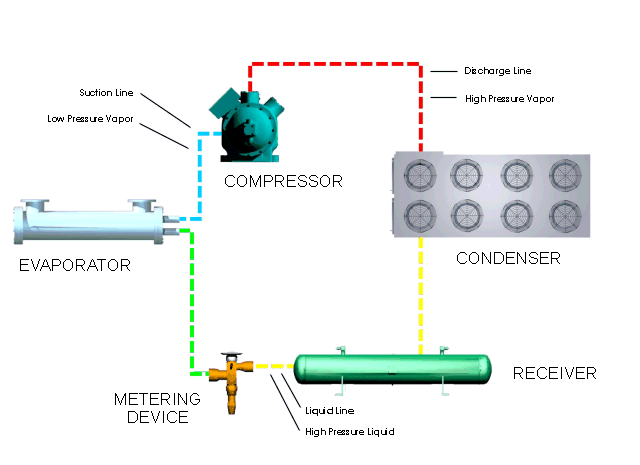
- The heat from the water is received in the evaporator of the chiller. This is due to the low temperature of the coolant at this point.
- The heat coming out of the water causes the refrigerant to change its state of saturated mixture (Saturated liquid plus saturated steam) to the state of Superheated Steam.
- This process occurs in the coolant at almost constant temperature, plus a small increase in temperature (overheating).
- The water being in a single state decreases its temperature (loss of heat). Now we have “Ice Water”.
- The refrigerant leaves the evaporator to the compressor to raise the pressure and facilitate condensation.
- Due to the heat exchange with the environment, at the condenser outlet the refrigerant becomes liquid again but still at high pressure.
- The refrigerant must now pass through the expansion valve, to return to low pressure and temperature, and thus the cycle repeats.
- The water leaves the exchanger at a lower temperature, and is brought to the application by a hydraulic system always in a liquid state.
- The water returns from the application at a higher temperature and re-enters the chiller to cool down again.
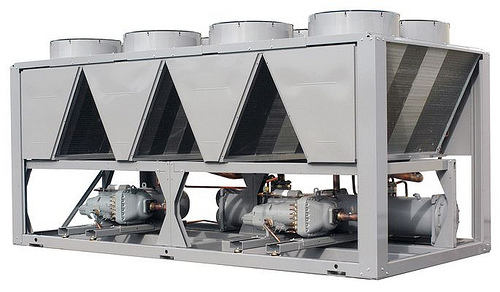
Refrigerants used in chillers
| Refrigerant Chiller | Refrigerant type | Characteristics |
| Chiller with R-12 | CFC | Its use is prohibited, by destruction of that of ozone. |
| Chiller with R-22 | HCFC (pure) | Start your ban in 2010. |
| Chiller with R-123 | HCFC (pure) | t is used in chillers Centrifugal. Forbidden by the Protocol Montreal. |
| Chiller with R-134a | HFC (pure) | Used for compressors displacement positive, and centrifugal. |
| Chiller with R-32 | HFC (pure) | It is a chiller of great efficiency, much used in applications of reversible chillers. Your restriction is its slight flammability |
| Chiller with R-404A | HFC (mixtures) | It is a chiller used for reach temperatures lower than the conventional. |
| Chiller with R-410A | HFC (mixtures) | R-410A does not exhaust the ozone layer and it is not flammable, made up of HFC-32 and HFC-125. |
| Chiller with R-407C | HFC (mixtures) | This refrigerant is used in chillers, to replace to R-22 |
| Chiller with R-1234yf | HFO | It is a chiller that works above all with compressor centrifugal. |
| Chiller with R-514A | HFO (mixtures) | It is a refrigerant for replace r-123 in existing chillers. |
| Chiller with R-515B | HFO (mixtures) | Is an alternative low potential global warming, as a replacement for R134a and HFO-1234ze |
| Chiller with R-513A | HFC+ HFO | It is an alternative for the replacement of R-134a in Chillers already existing. |
| Chiller with R-452B | HFC+ HFO | The R-452B is a replacement of R-410A and acquisition of new equipment. |
Chiller Types:
Chiller with water-cooled condenser compared to air-cooled.
Depending on the environmental conditions and the resources that exist, the most suitable chiller can be selected and the efficiency of an installation can be increased.
For example, in places with high humidity, the efficiency of an air-cooled condenser chiller approaches that of a water-cooled condenser chiller because the relative humidity is higher.
When the environment has lower humidity and a sufficient amount of water, then a water-cooled chiller can offer considerable savings in electrical energy.
However, other important parameters to consider must be taken into account.
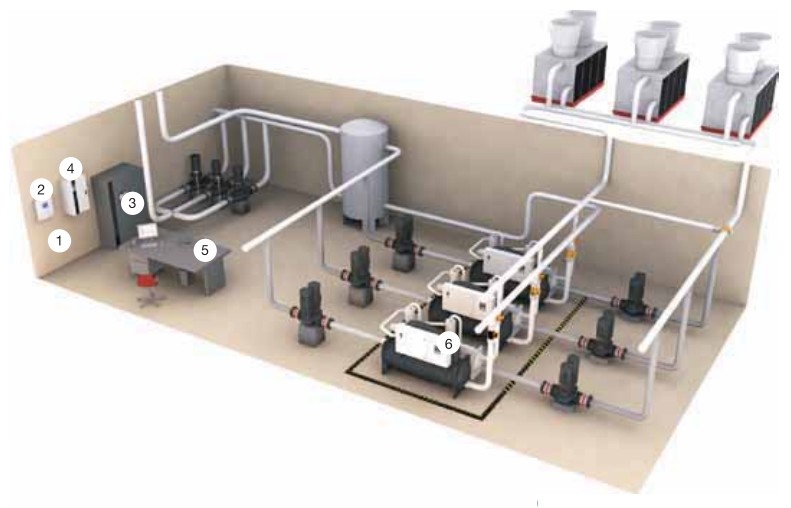
HOW SHOULD YOU DESIGN THE DISTRIBUTION OF THE WATER THAT GOES THROUGH THE CHILLER?
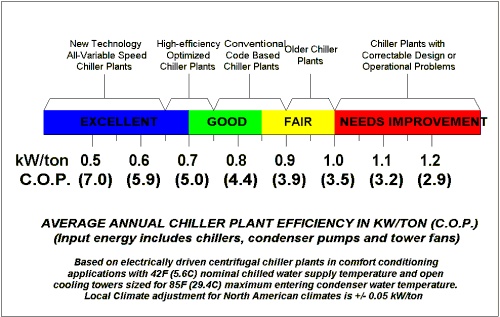
The distribution of the water will depend on the purpose of the installation
For example, an application for air conditioning will have practically the same temperature differentials in most points of the system and it is not necessary to mix or bypass water for a special requirement.
In Industrial applications, the temperature value requirements may not be the same at all points.
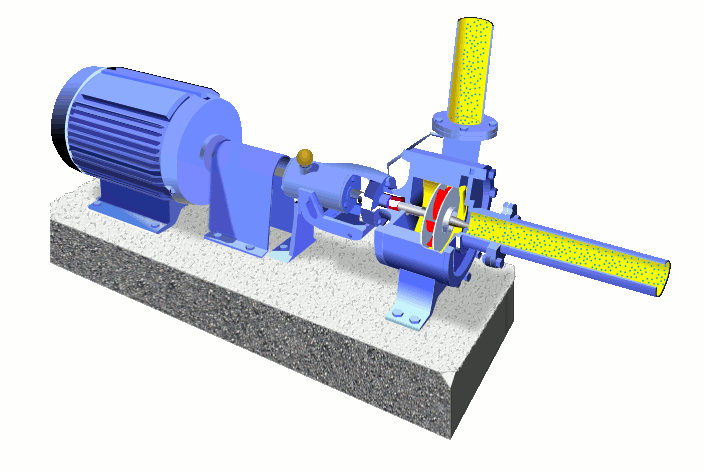
Why participate in our chiller training courses?
- The Course Content is Complete and starts from Zero.
- Pedagogical material in various formats; html, pdf, excel, etc.
- Support computer applications such as machine simulators.
- Self-assessment exercises in test mode where the student can check their progress.
- Consulting service for the student.
Objectives of the Chiller Training Program Online:
- Understand the operation of the compression refrigeration cycle present in chillers.
- Master the Chiller Selection Procedures according to the requirements presented
- Explain the fundamental control principles applied in chillers
- Identify the main components of the facilities with chillers
- Study installation design techniques with chillers.
- Learn the predictive, preventive and corrective maintenance techniques applied in plants with chiller.
Contents of the Online Training Course on Industrial Chillers
- Chiller refrigeration cycle.
- Chiller Types and Applications
- Calculations and selection methods for chiller.
- System components according to type of chiller .
- Control strategies in different types of chiller.
- Design of water installations in chillers.
- Maintenance techniques applied in chillers.
A complete course with the control strategies of the most important brands of chillers: Carrier, Trane, York, Daikin
WHAT IS THE METHODOLOGY OF TRAINING?
- The contents of our courses are pedagogically ordered.
- Access to texts, videos, facility simulators, consulting with a teacher.
- Assessments to check student progress.
- All the advantages of online courses, access to the platform 24 hours any day of the week.
WHO IS THIS COURSE FOR?
A course for Participants with basic knowledge of refrigeration
WHO DEVELOP THE CHILLER COURSES AT CONFOREMPRESARIAL?
We work with a team of specialist engineers with extensive experience present throughout the learning process.
HOW LONG IS THE COURSE?
The time depends on the participant, on average more than three months.
You may be interested in this Summary of Basic Concepts for Beginners in System with chiller
Download Here The 22 Concepts of Chiller for Beginners
CHILLER WITH SCROLL TYPE COMPRESSOR:
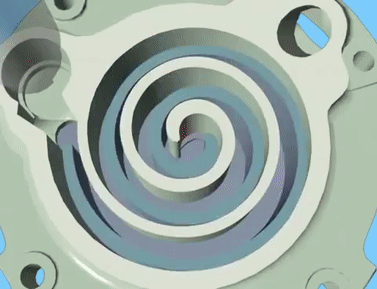
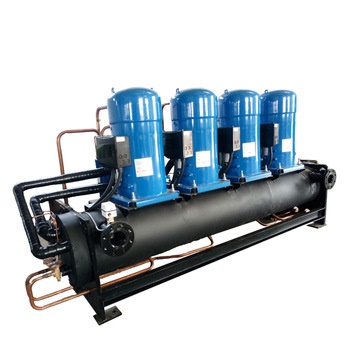
- These compressors are mainly used in equipment between 35 and 1400 kilowatts, that is, between 10 and 400 tons of refrigeration.
- The scroll compressor contributes to good energy performance and reliability.
- They can be found with a water-cooled condenser or an air-cooled condenser.
- Fewer moving parts.
- Less noise.
- Greater resistance to breakdowns.
- They have a better resistance to liquid shocks
- Better volumetric performance, close to 100%
- Less vibrations.
- Capacity regulation can be done by number of compressors on.
- Digital scroll compressors allow the equipment to adapt to the thermal load of the installation with great accuracy.
- New generation Scroll compressors have better resistance to liquid refrigerant.
CHILLER WITH SCREW COMPRESSOR:
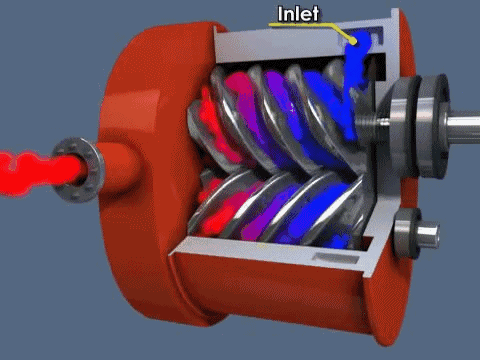
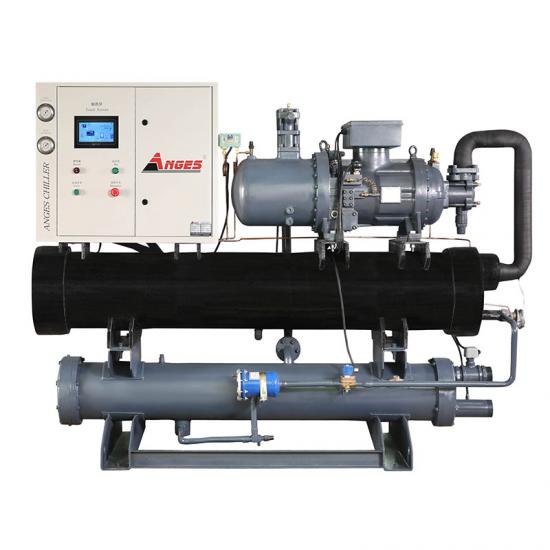
- Variable volume chambers are formed between the housing and the screw with rotation.
- Coolant suction starts at one end of the rotor block.
- The compression of the gas is achieved by the progressive approach of the lobes, producing the reduction in volume occupied by the gas.
- The compressor has a suction port and two discharge ports, one axial and the other radial.
- The regulation is made by means of a sliding valve, achieving that part of the refrigerant gas introduced for compression is returned to the suction without being compressed.
- The reduction in absorbed power is proportional to the reduction in cooling capacity.
- The capacity control of these compressors can be carried out continuously, between 10 and 100% of the maximum value.
- Single-screw compressors regulate their capacity following the same principle as double-screw compressors, replacing the longitudinal slide with a rotating ring.
- There is also the possibility of using two-speed motors in conjunction with the slide valve.
- The number of compressors for the same power is much less than the number required for scroll compressors.
- Regarding volumetric performance, the screw compressor achieves excellent results, bordering on 100%.
- These compressors are mainly used in a range between 252 and 1925 kilowatts, that is, from 75 to 550 tons of refrigeration.
- They can be found with air-cooled condensers and quieter and more efficient equipment with a water condenser, the latter generally being of greater capacity.
- Screw compressors do not yet accept liquid.
Chiller with centrifugal compressor:
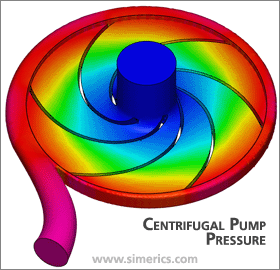
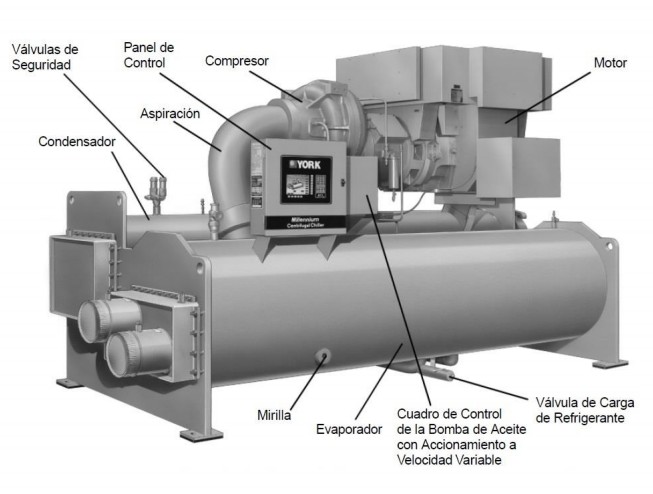
- The centrifugal compressor basically consists of a drive wheel, mounted on a shaft enclosed in a cover.
- The coolant enters through the center and is radially accelerated in the impeller.
- When the coolant passes through the blades it accelerates and is collected by a volute, where the acceleration is converted into pressure energy.
- Multi-stage compression with intermediate cooling and continuous partialization is often used.
- Oil elimination and therefore better performance in the chiller evaporator and condenser.
- Low wear over time and therefore, longer duration.
- Elimination of vibrations in any working condition, including the starting phases.
- These compressors precisely control the water temperature at the outlet of the chiller evaporator.
- To adapt to the demand of the installation it uses the continuous modulation of the speed of the impellers, and the orientation of the blades at the entrance to the compressor.
- It allows considerable adaptability to the variation of thermal loads, reducing energy consumption.
- They offer a very high efficiency range, because the regularization of the flow is done with the revolutions of the compressor.
- They are generally observed in equipment from 700 to 5600 kilowatts, that is, between 200 and 1600 tons of refrigeration.
- The use of water-cooled condensers is more usual, this is due to the size of the equipment.
The Condenser is the Part of the Chiller that performs the heat dissipation:
There are basically two types:
Air cooled condenser
Water cooled condenser
AIR COOLED CHILLER:

- The air-cooled chiller condenser consists of a bank of finned tubes, through which the refrigerant circulates.
- The condenser is the part where the heat from the cooling water is dissipated.
- The environment air is used as the medium, using axial type fans.
- Ice water delivers heat to the coolant.
- The refrigerant delivers heat to the ambient air in the condenser.
- For the physical form we have horizontal capacitors, in v or in w
WATER COOLED CHILLER CONDENSER:
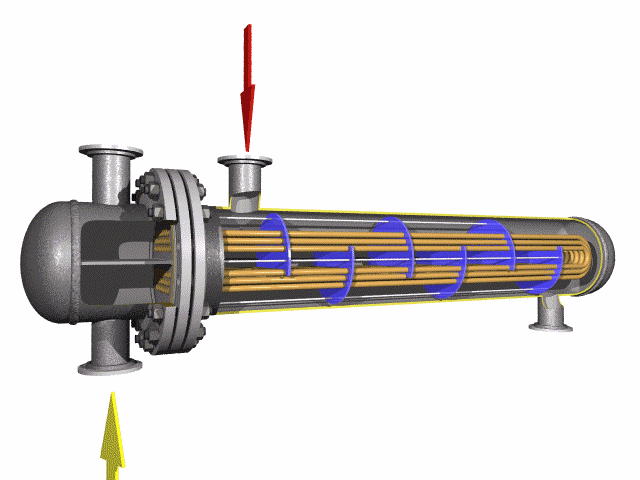
This condenser dissipates the heat gained through the flow of water that passes through it.
- The water flow when leaving the condenser is taken to a cooling tower to finally remove the heat to the environment
- Chilled water passes heat to the coolant
- Coolant passes heat to condenser water
- The condenser water passes heat into the ambient air.
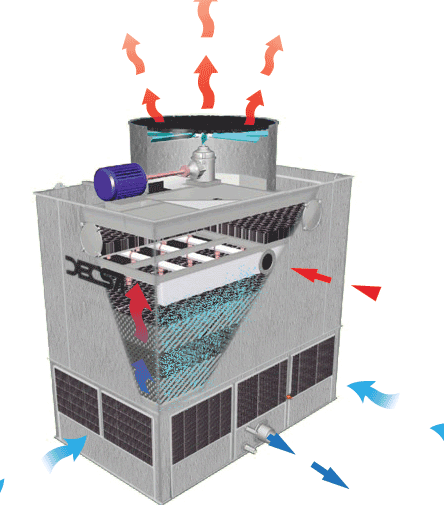
Expansion valve: Part of the Chiller to regulate the passage of refrigerant
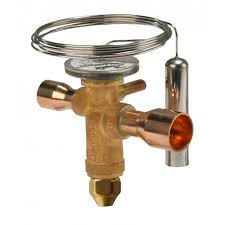
BULB THERMOSTATIC EXPANSION VALVE:
- This valve is in charge of controlling the mass flow of refrigerant that enters the evaporator.
- The objective is to ensure a good performance of the installation.
- The Valve protects the compressors from the arrival of refrigerant in a liquid state.
- It allows reaching the required temperature values in the water.
- It has a bulb that is placed at the outlet of the evaporator. Inside which there is a fluid that according to the temperature transmits a pressure value to the valve.
- With the pressure of the bulb, the area of passage of the refrigerant opens or closes.
- The idea is to have a refrigerant temperature differential between the evaporator inlet and outlet of 10 ° F.
- The temperature differential is called overheating.
- In Scroll compressor systems, operation with a thermostatic expansion valve works well in many applications.
- Systems with a thermostatic expansion valve are more economical.
ELECTRONIC EXPANSION VALVE:
- The electronic expansion valve controls the flow of refrigerant entering the evaporator, under different operating conditions.
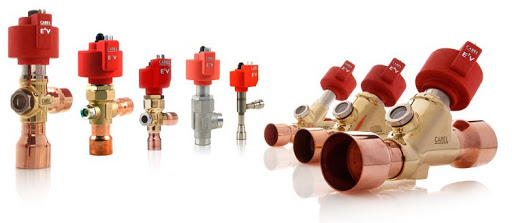
- The electronic expansion valve is less dependent on the type of refrigerant in the installation.
- It is very sensor dependent and very accurate.
- The regulation of the electronic valve is carried out with the movement of a hole, according to the information supplied to the controller by the sensors.
- It is possible to increase or decrease the area that the refrigerant flow needs to cross.
- For regulation the microprocessor controls the valve by voltage impulses.
- The hole is controlled by a stepper motor through approximately 3,600 steps.
- The control strategy verifies the conditions according to the programming of the equipment approximately every three seconds.
- The idea is to maintain a refrigerant superheat according to the set point supplied by the user.
- Screw Compressor systems require operation with the electronic valve.
Evaporator: It is the part of the shriek destined to the cooling of the water.
The main types of these heat exchangers are:
Double Tube Exchangers:
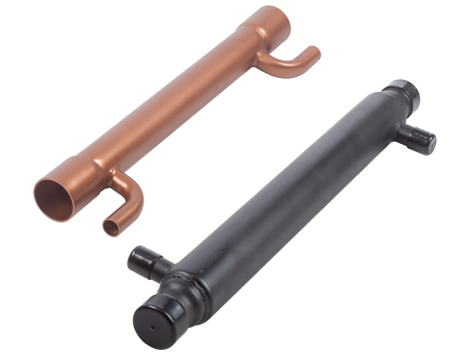
- This is the simplest exchanger equipment and is used for basic processes.
- It is formed with two concentric tubes: one fluid circulates through the inner tube and the other through the space formed between the two tubes.
- The flow rate of the fluid to be cooled is usually very low.
- In high thermal loads, a large number of these equipments are required, becoming practically unsustainable.
Shell and Tube Exchangers:
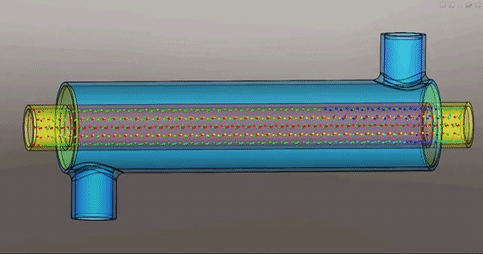
- It consists of a series of tubes that are placed in a cylindrical shell, held at each end by perforated sheets.
- They can be dry expansion or flooded.
- It consists of a steel tank with a certain amount of liquid through which the refrigerant passes, the liquid passes outside.
- If the evaporator is flooded, the liquid to be cooled passes through the tubes and the refrigerant through the casing.
Plate Heat Exchangers
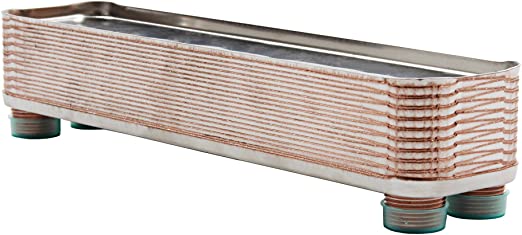
- This type of exchanger is having an increasing use in the industry.
- It offers space, energy and efficiency savings in heat exchange.
- Fluids pass separately through steel plates or other material.
- Thermal exchange is carried out through the surface of these plates.
- The plates can be welded, semi-welded, or simply fitted through gaskets.
- It is used in applications with high levels of sanitary cleaning, such as milk pasteurization, among others.
Tank type evaporator
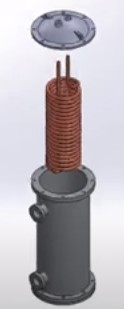
- The tank-type evaporator consists of a bare tube heat exchanger, installed inside a tank that contains the liquid to be cooled.
- The liquid to be cooled runs through the coil driven by a motorized agitator.
- This cooler is used in those cases where cleanliness is not an important variable.
- It is used in applications with large and frequent fluctuations in the thermal load.
- It is used when the liquid enters the cooler at relatively high temperatures.
- It is used for cooling water, brine and other secondary coolants.
Chiller According to your Application:
- Air Conditioning Chiller System
- Chiller For Industrial Processes
Air Conditioning Chiller System
Why use Air Conditioning Chiller System ?
- A chiller type air conditioner uses a lower quantity of primary refrigerant, because the measurement depends exclusively on the size of the refrigeration circuit.
- The installation space that handles the primary refrigerant will be limited by the Evaporator Size, Condenser Size, and Length of connecting pipes.
- The cold water generated in the evaporator or secondary refrigerant is transferred to the application to be air-conditioned, thus avoiding unnecessary pipes with primary refrigerant.
- The dimensional characteristics of volume that you want to condition do not matter.
- Cold water can circulate through the entire application, either through PVC or stainless steel tubing.
- The water is powered by a system of pumps.
- It is much more practical to move water, considering that cold air could also be transported.
- Producing cold air and taking it to a distant application requires a more expensive duct system, probably louder, less efficient and with greater space requirements.
Where do we find air conditioning chiller system?
- In shopping malls, administrative centers, hotels or distribution centers, or any application where we have considerable distances from the generation of “cold” to where that condition is needed.
- The use of this equipment is more and more common, because its maintenance cost can be significantly reduced when we use a chiller whose condensers use air for its operation.
What are the main parts of the air conditioning chiller system?
Air-Handling Unit:
- It is connected to receive ice water from the chiller. Outside air also enters, this air passes through flat and angular filters. A fan drives air through finned coils through which water circulates.
- It allows to carry out a comprehensive air treatment, used in the air conditioning system.
- It allows controlling variables such as:
Ventilation (contribution of outside air).
Air quality (filtered).
Temperature (heating or cooling).
Humidity (humidifying in winter and dehumidifying in summer).
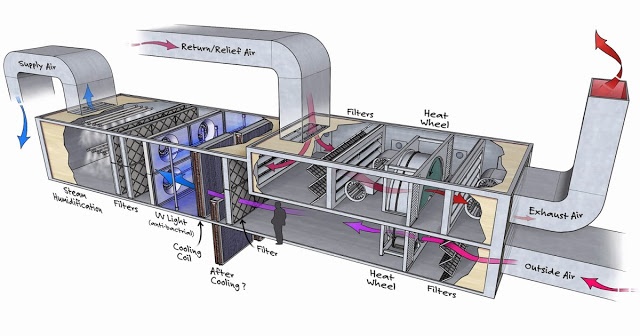
WHERE ARE THE AIR-HANDLING UNITS USED?
They are usually used mainly in:
- Requirement of contribution of air from outside in air-conditioned areas.
- Air conditioning in premises with high occupant density
- Air conditioning of spaces not so large, but with high comfort or health requirements: such as laboratories, operating rooms, etc.
WHERE ARE THE AIR-HANDLING UNITS LOCATED?
For this there are two concepts:
Compact Air-Handling Unit:
They consist of a single module in which the different stages of air treatment are included. There are versions for outdoor mounting and specific reduced height versions for installation in false ceilings.
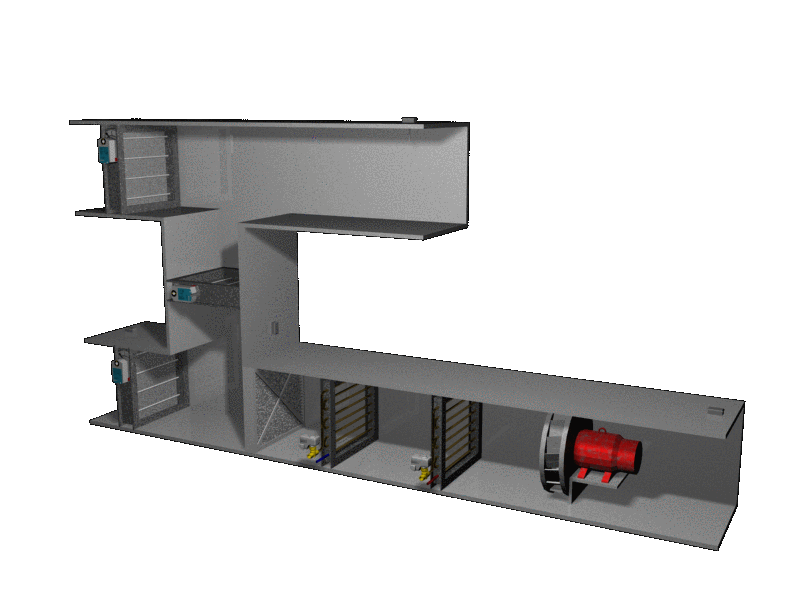
Modular Air-Handling Unit.
In most cases, they are equipment of a considerable size, which is why it is usually necessary to locate them on the roof of the building or in a specific place that has direct ventilation to the outside, in order to take and extract air.
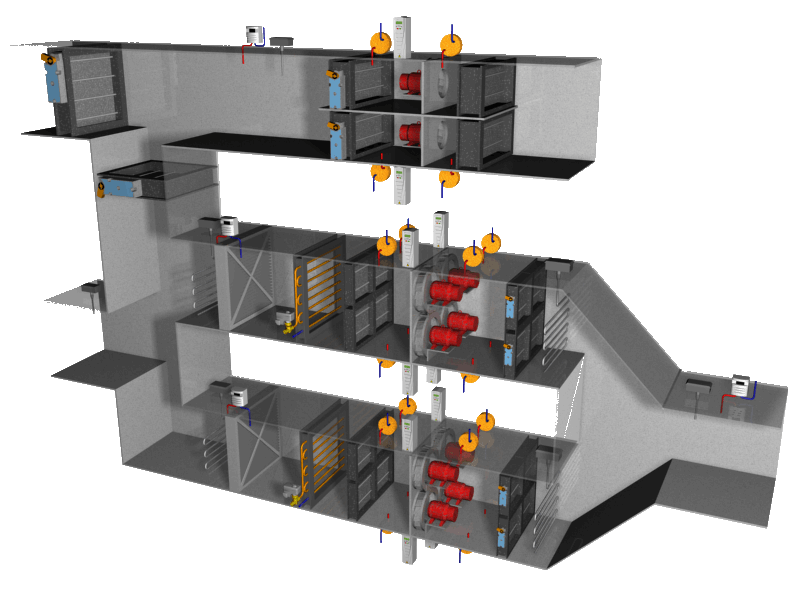
Fan-Coil:
It is a team essentially with a heat exchanger (copper tubes and aluminum fins), to pass cold or hot water, it has a fan to conduct outside air through the exchanger.
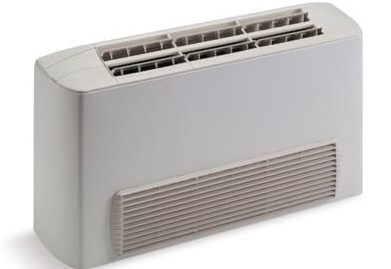
WHAT ARE THE ADVANTAGES OF FAN COILS?
- It is a very efficient air conditioning system.
- Applicable both in residential, commercial and industrial settings.
- Ideal for large spaces.
- They are equipment that require little space and are easy to install.
- It can provide both cold and heat.
Ductwork:
They are used to bring cold, dry air from the fan coil or air handling unit to the rooms.
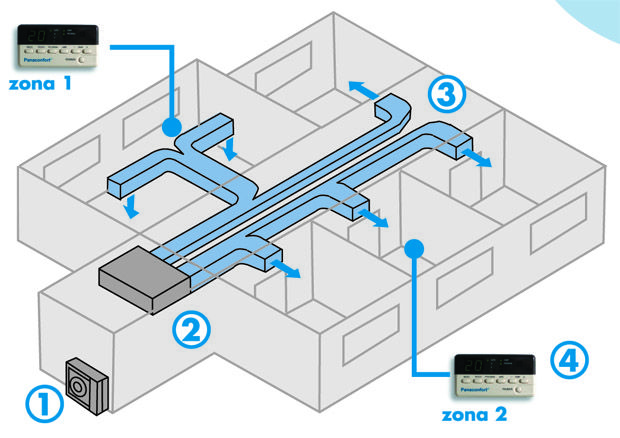
Zone Dampers:
They are used for temperature control in different environments, it acts controlled with the temperature of the environment within the ductwork.
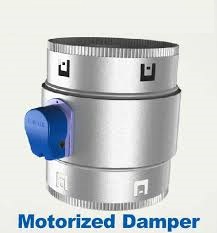
Bypass Dampers:
They are used to divert air from the supply duct to the return of the Air-Handling Unit, it acts controlled with the static pressure in the supply duct
Fresh Air Dampers:
They are used for the control of fresh air, it acts controlled with the CO2 sensor at the fresh air inlet, inside the duct or at the fresh air window.
Static pressure sensor:
They are used for pressure control in the supply line.
Proportional motorized valve:
They are used to control the water flow in the Air-Handling Unit, it acts controlled with the return air temperature.
Bypass valve:
They are used to control the flow of water in the system, it acts controlled with the differential pressure of water in the system. It is located in the chilled water bypass pipe.
ON-OFF motorized valve:
They are used for closing the flow of water to the chillers. It is located in the chilled water outlet pipe at the chillers outlet.
WHAT TO DO BEFORE BUYING THE CHILLER
We are going to list the steps to select the correct chiller.
Step 1.
Calculate the thermal load of the installation, to ensure that the chosen chiller is large enough. In addition, in this step, the flow of water that the chiller will handle must be calculated.
Step 2.
Select the type of cooling for the chiller condenser.
If the selection is an air-cooled chiller, it should be noted:
Where the condenser will be located indoors or outdoors, the height of ceilings, obstructions, walls, the highest and lowest ambient air temperatures, and the general location.
If instead the selection of the chiller is cooled by water, it must be taken into account.
What is the source of water you have, and its capacity in gallons per minute.
Consider whether the water will need filtration, before it enters the chiller condenser.
Step 3.
Consider whether the chiller condenser will be a packaged system or remote condenser.
Step 4:
Evaluate the accuracy of the temperature control required by the process.
If tight temperature control is needed, you may need a two-loop process cooler, to keep a tank on board, or separate at a specific temperature.
Step 5:
Evaluate the Voltages available to the chiller.
It must be taken into account, what electrical work is required to power the new cooler, depending on the voltage you select.
Also consider, what voltage could potentially be more efficient during operation.
Step 6.
Performance curves and parameters should be used to select a model that meets or exceeds the required capacity, based on the temperature of the chilled water supply, and the highest expected ambient temperature.
The margin of safety of the application must be considered, with respect to the sizes of coolers available.
Step 7.
Consider again the estimated inlet and outlet temperatures of the water to the chiller, to get an idea of the characteristics that the distribution should have.
If for example. there is a high temperature, in the water they return to the chili, only during startup and then reduced to the proper temperature range, special precautions may not be necessary.
But on the contrary, if the high return temperatures for the water are maintained, the corresponding design measures must be taken.
Step 8.
Assess what level of protection the ice water requires from freezing. To do this, take into account, which is the coldest temperature of the fluid during operation.
Step 9. Evaluate if the chiller requires a secondary pump, to distribute the chilled water in the application.
Step 10.
Know if the heat flow of the process to be cooled changes, will stop or be constant, to study the chiller at partial loads.
Step 11.
Information must be known are the water flow requirements, and the pressure value required by the process.
Step 12.
Check available pump performance curves to ensure that the pump will provide enough pressure at the design flow rate to meet the application.
Step 13.
Evaluate initial investment, operating cost of the chilers, consider spending on electrical energy, maintenance costs, and depreciation.
Step 14.
Take into account the type of refrigerant that the chiller will have, investigate future environmental restrictions of some substances in some areas.
Step 15.
Take into account available chiller brand endorsement, installation assistance, and warranty.
Dare to Present this Test for Beginners in Systems with Chiller:
Remember Our online chiller training has exclusive facility simulators.
Calculate the capacity of the chiller that your installation needs.
This Training Program can be studied only in English or Spanish.
What is the Chiller Calculation?
The Chiller Calculation It is the first step that we must do to find the cooling capacity that the equipment to be installed must have.
How is the chiller capacity calculation performed?
The calculation of a chiller depends on the use that the unit will have, for example:
Calculation chiller for industrial applications.
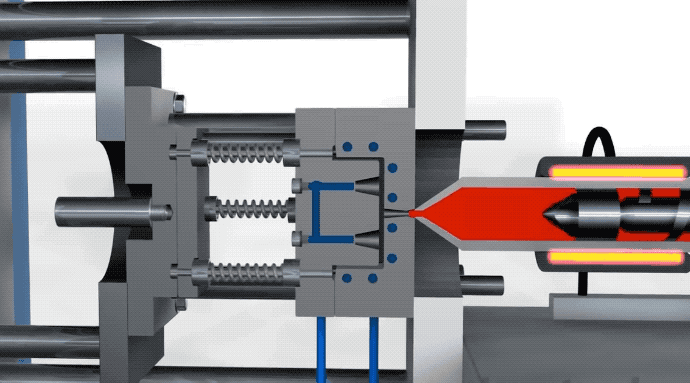
Chiller calculation in air conditioning applications.
